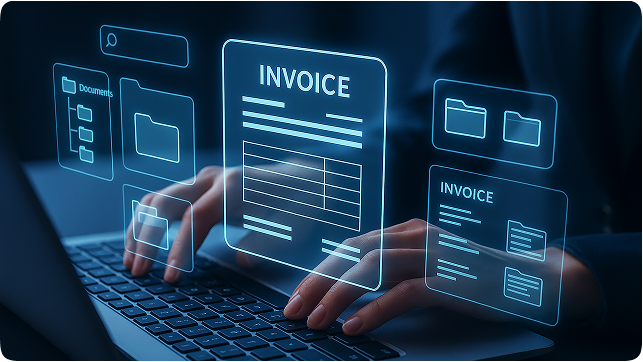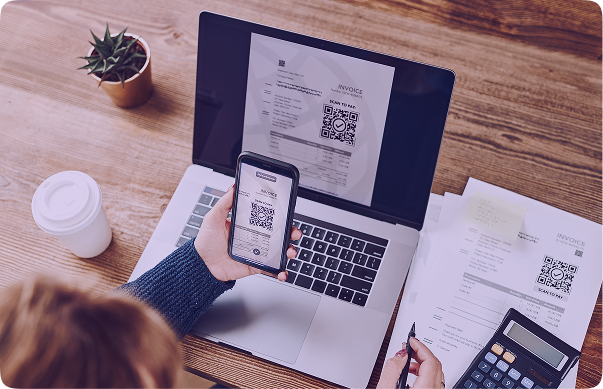Invoices are the pulse of every company, but handling them manually? That is equivalent to typing with a typewriter in the era of phones.
Automation is reshaping today’s finance teams, and Invoice OCR is at the forefront of the revolution. It is the invisible powerplant that converts paper disorder into digital sanity, enabling companies to process their bills faster, more precisely, and with minimal effort.
But what is Invoice OCR really, and why is it even more crucial to contemporary finance teams? Let’s find out.
What is Invoice OCR?
Invoice OCR or Optical Character Recognition is a process that allows computers to read and process information contained in invoices, scanned photos, PDFs, or photos. Rather than a person keying in all this information by hand, Invoice OCR does this immediately and precisely, freeing up time and minimizing errors.
How OCR Technology Works in Invoice Processing
OCR can sound like magic, but actually, it is a combination of scanning, recognition, and validation that is really smart. Here is how this process works in detail.
Scanning and Extracting Invoice Data
The workflow starts with scanning or uploading bills however they arrive in, as PDFs, photos, or even cell phone photos. The OCR engine recognizes regions containing information within a document with image processing and pattern recognition.
For instance, if you are uploading a group of vendor bills, the system will extract information such as bill no/invoice no, supplier name, and no. of lines etc. from each document.
Extracting Key Information
Once the document is identified, OCR software utilizes machine learning and natural speech processing (NLP) to decipher the layout of the document. It doesn’t merely consider words; it recognizes context.
For example, if it recognizes “Invoice No.” or “INV#,” then it is aware that the following series is most probably an invoice number. Also, it is able to conclude that the amount following “Total” or “Amount Due” is payable.
This level of intelligence assists the system in properly retrieving all the relevant fields, even if other formats, fonts, or languages are used by the invoices.
Validating and Arranging Data
After extraction, OCR doesn’t quite finish there. OCR certifies the information, verifying if the charges are right, dates are correctly formatted, and supplier name is consistent with your database. After verification, everything is neatly put together and just transferred into your financial systems to process payments.
Briefly, OCR converts incorrect, disordered invoice data into clear, actionable information.

Common Challenges in Manual Invoice Processing
Prior to understanding the strength of OCR, we will consider why manual invoice processing is a throbbing trouble spot for finance teams.
Time-Consuming Tasks – Entering invoice information manually into financial programs can consume hours. Mass that times hundreds of bills per month, and that spells a tremendous productivity loss.
High Error Rates – Even the best employee is bound to err, a wrong number, a wrong decimal place, or a wrong field. Errors this small can result in invalid payments or late vendor payments.
Ineffective Resource Utilization – Finance teams waste their time performing repetitive, low-value activities rather than dedicating their time to analysis, budgeting, or strategic planning.
Inability to Deal with Huge Quantities – As companies increase in size, volumes increase. Processing hundreds (or thousands) of bills manually can result in processing delays, disgruntled vendors, and lost early payment discounts.
Compliance Risks – They become more difficult to sustain an audit trail or meet tax and accounting requirements. Invoices can easily get lost or go missing, turning into a compliance nightmare.
Non-Existent Central Data Management – You get bills from various places, email, vendor sites, etc., Without a central system, managing them is a mess.
Non-consistent Invoice Styles – They work on various templates and formats. A person would find it difficult to adjust, yet OCR is able to discern and learn with variations over time.
Top Advantages of Utilizing OCR for Invoice Processing
Implanting OCR into invoice automation has quantifiable advantages that are applicable to any organization, whether small or big.
Less Manual Work
OCR eliminates manual data entry tedium, allowing financial professionals to work on higher-level activities. Consider handling hundreds of bills in a matter of minutes rather than days.
Fewer Mistakes, Greater Accuracy
By removing manual typing, OCR greatly minimizes human error. The outcome? Improved data with less mess, quicker approvals, and more accurate financial reporting.
Lower Processing Time
Invoices can traverse the approval process faster. Automation ensures prompt payments and even allows the chance of early payments with discounts.
Simplified Compliance and Audit Trail Management
With a digitized copy of each invoice kept in a centralized system, pulling records during audits or compliance verification is a breeze.
Intelligent Invoice Management
OCR allows for easy searching, filtering, and analysis of bills across timelines or suppliers. You can simply trace the status of payments or spot a pattern in your spend.
High Adaptability
AI-powered OCR systems learn with every new form of invoice. So, if a vendor modifies their layout a week from now, the system adjusts itself automatically without manual reconfiguration.

Top Advantages of Utilizing OCR for Invoice Processing
Modern Invoice OCR solutions go beyond traditional text recognition. They combine Optical Character Recognition (OCR) with Machine Learning (ML) and Artificial Intelligence (AI) to deliver exceptional accuracy.
- Machine Learning assists OCR programs in learning based on data patterns and self-correction with time. The more orders that are processed by the system, the wiser it becomes.
- Natural Language Processing enables OCR engines to comprehend the meaning, ruling out invoice numbers, dates, and amounts.
- Computer Vision improves detection of words, so even poor-quality or scanned photos are legible.
For example, iCaptur OCR engine employs AI-based models that can adapt to various formats, languages, and document types, achieving high uniformity in data capture accuracy.
How Accurate Is iCaptur OCR Invoice Data Extraction?
iCaptur’s Invoice OCR reaches above 95% in the majority of instances with a dependency on document quality. The system keeps improving with feedback loops along with training by AI, providing consistent outcomes for each type of invoice.
Getting Started with iCaptur’s OCR Invoice Data Extractor
Getting started with iCaptur’s invoice OCR is simple and fast, no technical setup required.
1. Upload your invoice — from email, folder, or directly from your accounting system.
2. Let the AI work — iCaptur’s OCR engine automatically detects, extracts, and validates all key fields like vendor, amount, and invoice number.
3. Export your data — seamlessly push the structured data into your ERP, accounting, or payment system.
That’s it! You get accurate invoice data ready for processing, without lifting a finger.
Frequently Asked Questions (FAQs)
1. Can iCaptur integrate with other systems?
Yes. iCaptur integrates easily with popular ERP, accounting, and workflow management tools for smooth automation.
2. Is my data secure with iCaptur?
Absolutely. iCaptur follows enterprise-grade data security protocols, ensuring your invoice data remains confidential and compliant with global standards.
3. How long does it take to process an invoice?
Depending on file size and complexity, iCaptur processes invoices within seconds.
4. Do I need technical expertise to use iCaptur?
No. The platform is designed for anyone, just upload invoices, and the system handles the rest.
5. What industries benefit the most from Invoice OCR?
Industries like manufacturing, logistics, healthcare, retail, and finance benefit greatly due to high invoice volumes.
6. Does Invoice OCR require special hardware or scanners?
Not at all. You can use any scanner, camera, or PDF upload. OCR works on digital and scanned documents alike.
7. Can Invoice OCR handle invoices in multiple languages?
Yes, iCaptur’s OCR supports multiple languages, making it ideal for global businesses.
8. How does Invoice OCR improve workflow efficiency?
By automating data capture and validation, it reduces manual intervention, speeds up approvals, and enhances visibility across teams.
9. Is Invoice OCR compatible with accounting software?
Yes. iCaptur integrates with major accounting systems, enabling seamless data flow.
10. What happens if an invoice is incomplete or unclear?
The system flags it for review, allowing users to manually verify or correct specific fields.
11. Can Invoice OCR detect duplicate invoices?
Yes, the system identifies duplicates based on key identifiers like invoice numbers and vendor details.
12. Can Invoice OCR be customized for unique invoice formats?
Absolutely. iCaptur’s AI engine adapts to different templates and learns from feedback.
13. Can Invoice OCR process handwritten invoices?
Yes, iCaptur’s advanced OCR engine supports handwriting recognition, provided the text is legible.
Final Thoughts
Manual invoice processing is no longer sustainable for businesses that value accuracy, speed, and scalability. Invoice OCR , especially AI-driven platforms like iCaptur transforms financial operations by reducing workload, minimizing errors, and enabling real-time insights.
So, if you’ve ever wondered “what is Invoice OCR”, now you know: it’s not just a technology, it’s the smarter way forward for modern finance teams.
Ready to save time and reduce errors in your invoice processing? Try iCaptur OCR today — or contact us to see how it can work for your business!
Enhancing your workflow through
AI integration is key to future success.
processes and improve efficiency!
I design and refine AI solutions that make workflows smarter and turn data into actionable insights. With expertise in OCR, deep learning, and computer vision, I focus on translating complex concepts into reliable, scalable systems that solve real-world problems and create measurable value.





